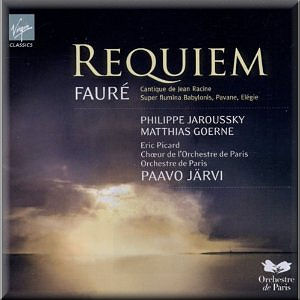 |
 |
|


alternatively
CD:
MDT
AmazonUK
AmazonUS
Sound Samples & Downloads
|
Gabriel FAURÉ (1845-1924)
Messe de Requiem, Op. 48 (1900) [34:50]
Cantique de Jean Racine, Op. 11 (1866) [4:53]
Élegie, Op. 24, for cello and orchestra (1895) [6:29]
Pavane, Op. 50 (1888) [5:39]
Super flumina Babylonis (1863) [9:57]
 Philippe Jaroussky (counter-tenor), Matthias Goerne (baritone), Eric Picard (cello)
Philippe Jaroussky (counter-tenor), Matthias Goerne (baritone), Eric Picard (cello)
Choeur de l’Orchestre de Paris, Orchestre de Paris/Paavo Järvi
rec. 8-13 November 2011, Salle Pleyel, Paris. DDD
 VIRGIN CLASSICS 0709212 [61:48]
VIRGIN CLASSICS 0709212 [61:48] 
|
|
|
Gabriel Fauré described himself as something of an agnostic.
This lack of religious conviction did not prevent him from holding
a series of positions as a church musician, the last at the
Madeleine in Paris. While there Fauré became tired of playing
other people’s music, and decided that he would write something
himself. The eventual result was the Requiem Mass. The Requiem
is gentle and consoling in mood, quite unlike the theatrical
and operatic Verdi Requiem. Its character is reinforced
by the unusual scoring, in which the top string line is taken
by violas - with the exception of a violin solo in the Sanctus.
Fauré’s mastery of writing for the human voice combines with
his modal harmonies to create one of his most satisfying major
works. His Requiem treats the universal human experience
with dignity and intimacy.
This Requiem, together with the other works on the disc, is
taken from live performances given in the Salle Pleyel - according
to the liner-notes, about a fortnight ago! Järvi chooses
a deliberate tempo for the Introit, which tests the choir’s
breath control. His phrasing is quite moulded. Together with
the dry acoustic and the speed this gives an overall impression
of everything being throttled back. The tension in the Offertorium
sags a little until the cello phrase which introduces the
baritone solo. This is eloquently performed with lustrous tone
by Matthias Goerne. The sopranos don’t quite middle their high
note in the subsequent section, although they recover; such
are the hazards of live performances. Their entry in the Sanctus
is chaste, and their exchanges with the baritones are beautifully
done. The solo in the Pie Jesu is carefully built by
Philippe Jaroussky; he sings it movingly, although his tone
gets a bit thin at times. In the Agnus Dei, the downwards
arpeggio in the cellos which plunges the music into the minor
is played legato. I feel it is more effective played
with more detached phrasing. Goerne sings beautifully again
in the Libera me. Järvi injects a welcome touch
of drama into the mid-section. I admired the sopranos’ soaring
line in the finale, but their diction is quite mushy, which
is a fault of the choir throughout.
On playing my old set with the Choir of Kings College, the New
Philharmonia and David Willcocks, I was surprised at how much
closer this was recorded, something that assists the diction
of the choir. Their sound is also greatly enhanced by a much
more reverberant acoustic, in this case that of the Chapel of
Trinity College, Cambridge. Overall the Willcocks performance
feels more engaged. Järvi takes a cooler approach - although
this is a legitimate view of the work - and he has two first-rate
soloists. The top lines in the choir do not have the fullness
of sound of some mixed ensembles, but their rather “white” tone
has a purity that suits the work.
The brief Cantique de Jean Racine is for mixed choir
and orchestra; its being assigned Op. 11 is slightly misleading,
as Fauré reserved his first 10 numbers for early works that
he might want to revive. Järvi favours the orchestra over
the choir in the balance, something not helped by the choir’s
diction, which is again indistinct. The Elegy for cello
and orchestra is a little out of place in this collection of
Fauré’s choral works, but it is well played by Eric Picard who
is Principal with the Orchestre de Paris.
The Pavane is a setting of a text by Robert de Montesquieu,
and features one of Fauré’s most languorous melodies. This is
elaborated with great skill, and the orchestration and choral
writing combine to make this one of his miniature masterpieces.
The performance features some delicate wind playing, and is
very well paced. The Willcocks/Kings recording also features
the orchestral version of this work, but it is interesting to
hear the full arrangement as given here.
Super flumina Babylonis is one of Fauré’s earliest works,
and shows his developing ability in writing for choir, soloists
and orchestra. The mid-section is a bit four-square, with rather
silly “parp-parp” horn writing. It is really a work of interest
to Fauré fanatics, but the performance - with different vocal
soloists than the Requiem - gives a good account of it.
These shorter pieces come off rather better than the Requiem,
in which Järvi does not always sound very interested. This
work does contain some very good things, however, particularly
from the soloists, and certainly never falls below an acceptable
level.
The liner-notes are interesting and contain the full texts of
all the works - albeit not in the order in which they appear
on the disc. Overall this disc offers a convenient and well
performed compilation of Fauré’s choral music.
Guy Aron
|
|

